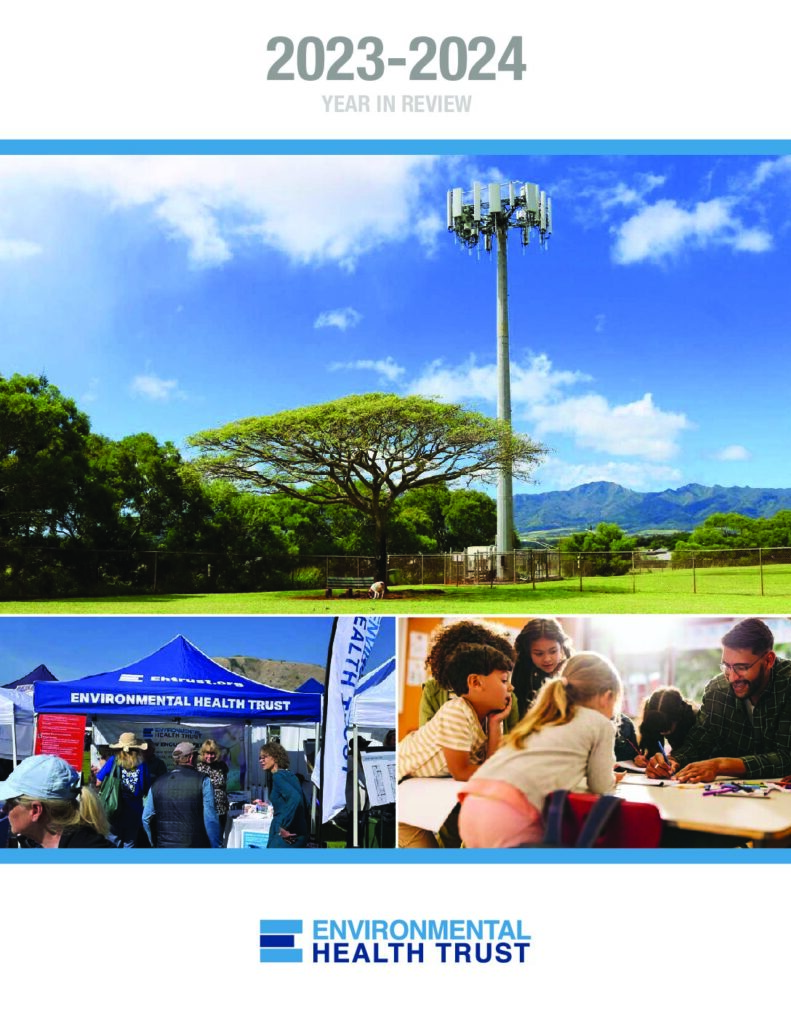
ABI Research White Paper: 5G and Energy Consumption
A 2020 ABI Research DataCenter Forum white paper Environmentally Sustainable 5G Deployment reports that 5G could increase power consumption by 61 times from 2020 to 2030. This is one of numerous industry report stating that 5G and the phenomenal growth in internet traffic from the internet of things will dramatically increase energy consumption.
Environmental Health Trust has compiled a list of White papers and research report documenting the increased energy consumption from 5G and wireless networks. Please download EHT’s List of Studies on 5G and Increased Energy Use and EHT’s Factsheet on 5G and Climate Change
Excerpts from the white paper:
“As 5G usurps LTE, energy consumption is expected to increase 61x between 2020 to 2030 due to the energy demands of powerful network elements like massive MIMO and edge servers, the proliferation of 5G cell sites, and the flexibility of the 5G networks in both consumer and enterprise use cases”
“Power consumption of the 5G network is expected to soar due to active network elements like energy-hungry baseband units, remote radio heads, small cells, and core networks”
“As 5G deployment continues to gain momentum, the energy consumption of cellular network will outpace the energy consumption growth in many countries. Growing at 9% CAGR, the cellular network is expected to grow at the same rate as prominent emerging economies in the world, such as Vietnam and Bangladesh. By 2030, global cellular network will break into the top 20 ranking for the global household or domestic energy consumption ranking by country, consuming 51.3 Mtoe per year, or roughly the same amount of energy as all the households in Australia and the United Kingdom.”
“end devices constituting 37% of the overall energy consumption of the cellular network by 2030”
Environmental Health Trust is working to ensure that the environmental footprint of 5G and future networks be considered. Streaming with wireless results in higher greenhouse gas emissions compared to safer, faster, and more secure corded/wired fiber-optic connections. The solution is two fold. Companies must not only actively manage and reduce their carbon emissions with more energy-efficient networks, device hardware/software changes, greener data centers and environmentally sustainable manufacturing processes. More importantly, communities must prioritize wired connections in homes and buildings as well as design end user devices with easy to use plug and play wired capabilities.
The report documents “key steps to make 5G Greener” stating that “Telefonica claims that they have achieved a global reduction of almost 50% of their CO2 emissions since 2015. Other major CSPs, such as BT Group, Deutsche Telecom, Orange, Verizon and Vodafone have made similar pledges to actively manage and reduce their carbon emissions.” The report states that currently steps being taken include:
- championing the adoption of renewable energy
- improving the energy efficiency of network elements and user devices through enhancement in data transmission, reduction of control-signaling overhead, and improvement in link adaption
- greening data centers with efficient cooling involving airflow design and management
- influencing stakeholders in the industry value chain to adopt similar standards and help to bring down the overall carbon footprint.
- more energy-efficient baseband units and antennas with selective switch-off of certain active RAN components. Basestations and small cells can be put dynamically into a sleep state when there is no traffic.
- speeding up the integration of AI algorithms to help to reduce unnecessary energy consumption equipment that is idle during low traffic scenarios.
- accelerate the use of renewable energy and passive equipment cooling.
- real-time site status monitoring help reduce maintenance workload in remote rural areas.
- Manage power utilization by various hardware and software components in a device.
- Make power efficiency as key requirement in procuring displays and display processing units.
- More power efficient video transmission
- Better battery technology
Environmental Health Trust has compiled a list of White papers and research report documenting the increased energy consumption from 5G and wireless networks. Please download EHT’s List of Studies on 5G and Increased Energy Use and EHT’s Factsheet on 5G and Climate Change
Reports and White Papers: 5G, Energy Consumption, and Climate
Data Center Forum White Paper, (2020) Environmentally Sustainable 5G Deployment
German Environment Agency and German Federal Environment Ministry (2020) “Fibre optic video transmission is nearly 50 times more efficient than UMTS”
High Council for the Climate Report (2020) “Controlling the carbon impact of 5G”
Huawei (2020) 5G Power: Creating a green grid that slashes costs, emissions & energy use,
Mills, Mark P., National Mining Association / American Coalition for Clean Coal Electricity (2013), “The Cloud Begins with Coal – Big Data, Big Networks, Big Infrastructure, and Big Power. An overview of the electricity used by the global digital ecosystem.”
National Resources Defense Council, 2014 “Data Center Efficiency Assessment”
Shehabi et al., Berkeley Laboratory (2016) “United States Data Center Energy Usage Report” PDF
Timothy Schoechle, National Institute for Science, Law & Public Policy, Washington, DC (2018) Re-Inventing Wires: The Future of Landlines and Networks
The Center for Energy Efficient Telecommunications (2013) “The Power of Wireless Cloud: An analysis of the energy consumption of wireless cloud”,
The Shift Project (2019) “LEAN ICT: TOWARDS DIGITAL SOBRIETY”: OUR NEW REPORT ON THE ENVIRONMENTAL IMPACT OF ICT”, PDF Summary
Vertiv 5G (2019) Telco Industry Hopes and Fears FROM ENERGY COSTS TO EDGE COMPUTING TRANSFORMATION
Katie Singer, Letters to Greta: Our Web of Inconvenient Truths
Scientific Publications on 5G, Energy Consumption, and Climate
Andrae, A.S.G.; Edler, T. On Global Electricity Usage of Communication Technology: Trends to 2030 Challenges 2015, 6, 117-157.
Baliga, Jayant, Ayre, Robert, Hinton, Kerry, Tucker, Rodney S. “Energy Consumption in Wired and Wireless Access Networks in IEEE Communications Magazine, vol. 49, no. 6, pp. 70-77, June 2011, doi: 10.1109/MCOM.2011.5783987.
Belkhir, Lotfi and Elmeligi, Ahmed. Assessing ICT global emissions footprint: Trends to 2040 & recommendations, Journal of Cleaner Production, Volume 177, 2018,Pages 448-463, ISSN 0959-6526, https://doi.org/10.1016/j.jclepro.2017.12.239.
Corcoran, Peter and Andrae, Anders. (2013).Emerging Trends in Electricity Consumption for Consumer ICT, Global Forecasting of ICT footprints,
Li, C., Zhang, J., and Letaief, K. B. Energy Efficiency Analysis of Small Cell Networks,” 2013 IEEE International Conference on Communications (ICC), 2013, pp. 4404-4408
Morley, Janine, Widdicks, Kelly, Hazas, Mike. “Digitalisation, energy and data demand: The impact of Internet traffic on overall and peak electricity consumption” Energy Research & Social Science, Volume 38, 2018, Pages 128-137, ISSN 2214-6296
Shehabi, Arman, Walker, Ben , Masanet Eric. (2014) “The energy and greenhouse-gas implications of internet video streaming in the United States” Environmental Research Letters
Sikdar, B. “A study of the environmental impact of wired and wireless local area network access,” in IEEE Transactions on Consumer Electronics, vol. 59, no. 1, pp. 85-92, February 2013
Xiaohu Ge, Jing Yang, Gharavi, Hamid. Energy Efficiency Challenges of 5G Small Cell Networks. IEEE Commun Mag. 2017 May;55(5):184-191. doi: 10.1109/MCOM.2017.1600788. Epub 2017 May 12.






